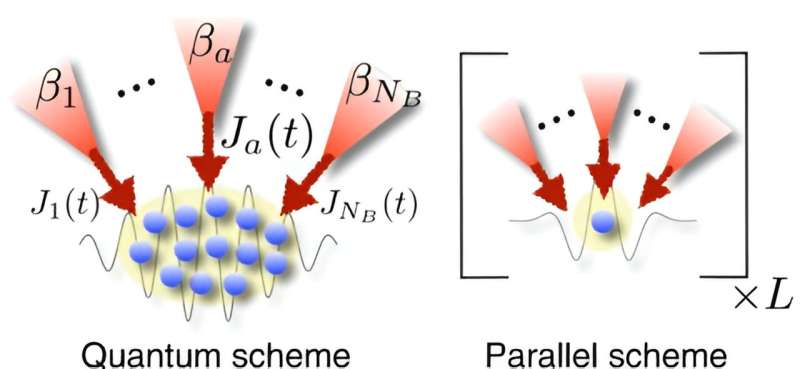This article has been reviewed according to Science X's editorial process and policies. Editors have highlighted the following attributes while ensuring the content's credibility:
fact-checked
peer-reviewed publication
trusted source
proofread
Deriving the fundamental limit of heat current in quantum mechanical many-particle systems

Researchers from the University of Tsukuba have mathematically derived the fundamental limit of heat current flowing into a quantum system comprising numerous quantum mechanical particles in relation to the particle count.
Over the past few years, research has been conducted on quantum technologies that exploit the quantum mechanical properties of microscopic entities. Quantum thermodynamics is a notable field in this domain. Within this field, quantum heat engines and quantum batteries, leveraging quantum characteristics, have been theoretically studied and practically tested.
A critical indicator of the performance of such devices is the magnitude of heat current (heat transferred per unit time) flowing from the ambient environment to the quantum system as the system's size increases. However, the fundamental limit of the heat current flowing into such an ensemble of quantum systems remains undefined.
In the study, published in Physical Review Letters, the researchers mathematically derived a novel inequality that defines the limit of the heat current flowing into a quantum system. Based on this inequality, they demonstrated that as a quantum system incorporates increasing number of particles, the heat current flowing into the system does not rise faster than a cubic function of the particle count.
Furthermore, they derived an inequality applicable under more realistic conditions wherein the heat current does not rise faster than a square function of the particle count. Interestingly, the phenomenon related to energy radiation termed as "superradiance" was identified as the most efficient mechanism for achieving the fundamental heat current limit derived in this study.
While earlier research has hinted at nonlinear heat current surge with respect to the particle count in various specific scenarios, this study is pioneering in pinpointing a fundamental limit that is universally applicable. Notably, these findings could be instrumental for cooling engines associated with quantum devices and other similar applications.
More information: Shunsuke Kamimura et al, Universal Scaling Bounds on a Quantum Heat Current, Physical Review Letters (2023). DOI: 10.1103/PhysRevLett.131.090401
Journal information: Physical Review Letters
Provided by University of Tsukuba




















